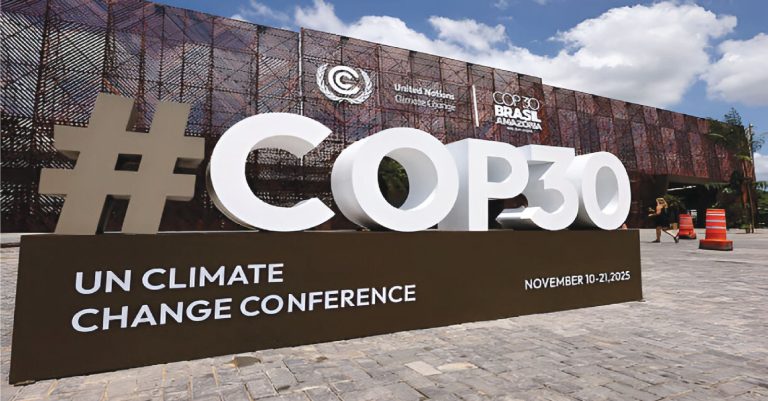Week 1 of COP30 in Belém, Brazil began with urgency and high expectations. Held in the heart of the Amazon rainforest, one of the planet’s most important ecosystems, the conference attracted over 56,000 participants, including negotiators, policymakers, scientists, business leaders, and civil society representatives.
The aim was clear: to accelerate global climate action. However, the first week revealed a mix of progress, hesitation, and warning signs. While some areas moved forward smoothly, others remained unresolved. Funding, accountability, and equitable collaboration continue to be major challenges.
Below is my concise analysis of Week 1 and its implications for governments, businesses, investors, and communities.
Gender and Climate Action: A 10-Year Plan Stuck at the Starting Line
The 10-year Gender Action Plan (GAP) was expected to be a highlight of COP30. Its goal is to ensure that climate policies and programs are inclusive and support women, who often bear the brunt of climate impacts.
Key facts:
- At COP29, gender-focused climate work was extended for ten more years, but no dedicated funding was provided.
- Developing countries are insisting on earmarked finance for gender initiatives.
- Developed countries prefer to include gender finance under general climate funding negotiations, which risks delays and lack of transparency.
Why it matters:
Empowering women has measurable impacts. Studies show that supporting women farmers can increase agricultural productivity by 20–30%, improve food security, and strengthen resilience to climate shocks. Without funding, the GAP risks being symbolic, not transformational.
Countries and organizations must secure dedicated funding for gender-focused climate programs, otherwise they will miss out on a key tool for adaptation and resilience.
Global Goal on Adaptation: Important but Stuck
Adaptation is about helping communities, countries, and ecosystems prepare for climate-related risks like floods, droughts, heatwaves, and food insecurity. The Global Goal on Adaptation (GGA) was expected to be a central theme of COP30, yet negotiations remain unresolved.
Challenges highlighted
- Countries disagree on how to measure adaptation. Indicators include water security, food system resilience, and climate-resilient infrastructure.
- Developing countries want immediate adoption to unlock funding. Some, like the African Group, propose a two-year work program to consult further.
Why this is serious
- Adaptation costs are rising rapidly, with estimates of $215–387 billion per year needed by 2030.
- Current adaptation finance covers only a fraction of this, leaving the most vulnerable populations at risk.
- Less than 5 percent of climate finance currently goes to agriculture, water, and food security, despite these being critical areas.
Implications:
Without timely adaptation, communities face crop failure, water scarcity, and extreme weather. For example, farmers in sub-Saharan Africa risk losing harvests due to drought, while flood-prone areas in South Asia struggle with inadequate infrastructure.
Agreeing on adaptation metrics is critical. Without them, countries cannot track progress, secure funding, or implement projects effectively.
Just Transition: Divisions Between Developed and Developing Countries
Just Transition focuses on ensuring that shifts away from fossil fuels are fair for workers, communities, and economies. Week 1 revealed sharp divides between developed and developing nations.
Points of contention
- Developing countries want a dedicated implementation mechanism under the UNFCCC and predictable funding for just transition projects.
- Developed countries oppose creating new structures or new funding windows.
- Trade policies, such as the EU Carbon Border Adjustment Mechanism, raised concerns about fairness and equity.
New development
For the first time, agriculture and food systems were included in Just Transition discussions. Agriculture employs over 1 billion people worldwide, highlighting the need for a fair shift in these sectors too.
Implications
If agreements are not reached, vulnerable populations may suffer economic hardship, and transitions could deepen inequality.
Science and Data: An Unexpected Challenge
Accurate science and reliable data form the backbone of every climate action plan. Decisions on adaptation, mitigation, infrastructure, and funding all rely on solid evidence. If the data is incomplete or disputed, policies risk being ineffective, and vulnerable communities suffer the most. Surprisingly, even this area became contentious during Week 1.
Key issues
- Some countries resisted including language to counter climate misinformation, slowing progress on science-based agreements.
- References to the IPCC (Intergovernmental Panel on Climate Change) reports were debated, with disputes over how inclusivity is defined.
- Developing countries highlighted significant gaps in their own climate observation and monitoring systems, making them reliant on external data sources.
- Funding for the Systematic Observations Financing Facility (SOFF), which supports climate monitoring networks globally, remains insufficient.
Why this matters
Without accurate climate data, countries cannot design effective policies or early warning systems for disasters. This increases vulnerability to climate shocks, especially in countries with limited monitoring capacity.
Implications
Strengthening global climate observation networks and supporting data systems in developing countries are critical for evidence-based policymaking.
Agriculture & Food Security: A Rare Bright Spot
Agriculture and food systems are at the center of climate discussions because they are both vulnerable to climate change and major contributors to greenhouse gas emissions. Ensuring sustainable agriculture is critical for feeding the world while reducing environmental impact.
Agriculture was one of the few areas that made smooth progress in Week 1.
Achievements
- The Sharm El-Sheikh Joint Work on Agriculture and Food Security moved from discussion to implementation planning, signaling clear progress.
- Countries agreed on a roadmap to 2026, aiming to integrate food systems more effectively into climate action planning.
Why is this important
Agriculture contributes to one-third of global emissions, consumes 70 percent of freshwater, and supports 2.5 billion livelihoods. Despite its importance, it receives less than 5 percent of climate finance.
Implications
Progress in this sector is vital for climate-vulnerable regions such as the Middle East, Africa, and South Asia. Improved food system planning can enhance both climate resilience and food security.
Article 6.8: Cooperation Without Carbon Markets
While most headlines focus on carbon markets, Article 6.8 of the Paris Agreement highlights an alternative path: climate cooperation that does not involve buying or selling carbon credits. This approach is particularly important for countries that are not ready to participate in carbon markets or where market mechanisms may not be practical.
Progress
- Countries reached consensus on improving the Non-Market Approaches (NMA) platform, which includes surveys, project assessments, and technical support.
- This progress is notable because much of COP30 Week 1 was marked by negotiation deadlocks in other areas.
Implications
- Non-market approaches provide practical tools for countries lacking carbon-market readiness, ensuring inclusive climate cooperation.
- By focusing on shared goals rather than financial exchanges, these initiatives can accelerate climate action in sectors like agriculture, energy, and ecosystem management.
- The consensus reached on Article 6.8 lays the groundwork for future collaborative projects that directly reduce emissions and enhance resilience.
Countries not yet ready for carbon markets can still collaborate and access support through these mechanisms.
Loss and Damage: Technical Progress but Limited Funding
Loss and Damage (L&D) refers to the economic, social, and environmental impacts of climate-related disasters that countries, especially developing nations, are already experiencing. Unlike mitigation or adaptation, L&D focuses on compensating and supporting communities when climate events cause irreversible damage.
Procedural progress was made on technical aspects of L&D, but core funding issues remain unresolved.
Key numbers
- Pledges so far total approximately $700 million, which is far below the actual losses experienced annually by developing countries, estimated at over $400 billion.
- Negotiators are still debating how to structure funding, including whether support should come as grants, loans, or insurance-based mechanisms.
Reality check
The current funding gap covers less than 0.2% of actual losses, highlighting the urgent need for innovative financial solutions.
Implications
Countries may need to develop internal strategies, including risk-transfer mechanisms, insurance schemes, and disaster preparedness plans, to reduce the impact of future events. Bridging the gap between pledges and actual needs is essential to ensure climate justice and resilience for vulnerable populations.
Climate Finance: The Core Challenge
Climate finance refers to the money mobilized by governments, institutions, and private actors to fund initiatives that reduce greenhouse gas emissions, build climate resilience, and support communities affected by climate change. It underpins every aspect of COP30 negotiations, from adaptation and mitigation to loss and damage.
COP30 introduced the Baku-to-Belém Roadmap, outlining global funding targets.
Targets
- Developed countries are expected to provide $300 billion per year by 2035.
- Total funding from all sources, including private and multilateral finance, aims for $1.3 trillion per year by 2035.
Key Debates
- Whether a specific sub-goal for adaptation finance should be included.
- How private capital can be mobilized at scale.
- The potential use of new funding sources, such as development bank reforms, carbon taxes, or levies.
- Establishing accountability mechanisms to track the delivery and use of funds.
Current reality
Annual climate finance for developing countries is $90–100 billion, leaving a $200 billion shortfall even for the minimum target.
This gap threatens the ability to fund adaptation projects, agriculture initiatives, and loss and damage measures, slowing global progress on climate goals.
Implications
- Closing the climate finance gap is critical to turning commitments into action.
- Governments, multilateral institutions, and investors will need to explore innovative financial instruments, such as blended finance, climate bonds, and public-private partnerships, to scale funding.
- Transparent mechanisms and milestones are essential to ensure funds reach those who need them most, while building trust between developed and developing countries.
In short, climate finance is the engine driving global climate action. Without it, even the most ambitious commitments will remain words on paper, and the most vulnerable communities will continue to bear the brunt of climate change.
What Week 1 Tells Us About the Road Ahead
Week 1 was a reality check:
- Most agenda items remain unresolved. Critical issues, such as gender-focused climate finance, adaptation metrics, and just transition mechanisms, are still under negotiation.
- Climate finance gaps are widening. Despite ambitious targets, current funding levels fall far short of what developing countries need.
- Science is still politically sensitive. Disagreements over references to the IPCC, misinformation, and observation network funding show that even foundational scientific evidence can be contested.
- Adaptation and just transition need firm commitments, not soft statements. Vague statements are not enough. Communities, workers, and farmers need tangible frameworks, milestones, and funding to implement resilient systems.
But there are positives:
- The shift from dialogue to implementation for agriculture and food security sets the stage for practical climate action. This is particularly important for regions highly vulnerable to climate shocks, like Africa, South Asia, and the Middle East.
- Article 6.8 progress opens new avenues for climate-smart agriculture, technology transfer, and ecosystem restoration, even where carbon markets are not feasible.
- Several foundational discussions, such as observation systems, loss and damage technicalities, and early financing frameworks, set the groundwork for ministerial negotiations in Week 2.
Implications for Governments, Businesses, and Investors
From a policy and advisory lens, Week 1 signals major shifts:
Adaptation metrics will reshape accountability frameworks.
Countries that prepare early for the Global Goal on Adaptation (GGA) and adopt indicator structures for water, food security, and climate-resilient infrastructure will be better positioned to secure funding.
Finance architecture is entering a restructuring phase.
New instruments, reforms in multilateral development banks (MDBs), and mandates for private-sector mobilization are expected.
Food systems are entering the climate mainstream.
Agriculture, food security, and water management are now central to climate discussions.
Investors and governments can anticipate a surge in agriculture-related proposals, financing windows, and national policy updates.
Non-market cooperation will become a stronger channel for climate partnerships.
Article 6.8 progress highlights collaboration that does not rely on carbon markets. Countries and investors can leverage this for technology transfer, capacity building, and ecosystem protection initiatives.
Loss & Damage will become politically unavoidable.
Countries must develop internal L&D strategies, risk-transfer solutions, and insurance frameworks to protect vulnerable populations.
Final Outlook
Week 1 of COP30 in Belém highlighted the urgency of climate action and the complexities involved in turning commitments into results.
COP30 Week 1 has been a reality check: the world understands the climate crisis but is still negotiating the “how” and “who pays”. The coming weeks are decisive. Success will depend on turning technical discussions into political agreements, finance commitments, and implementable action plans.
Belém sends a clear message: global ambition must be matched with resources, frameworks, and accountability otherwise, climate action will remain aspirational rather than transformational.






